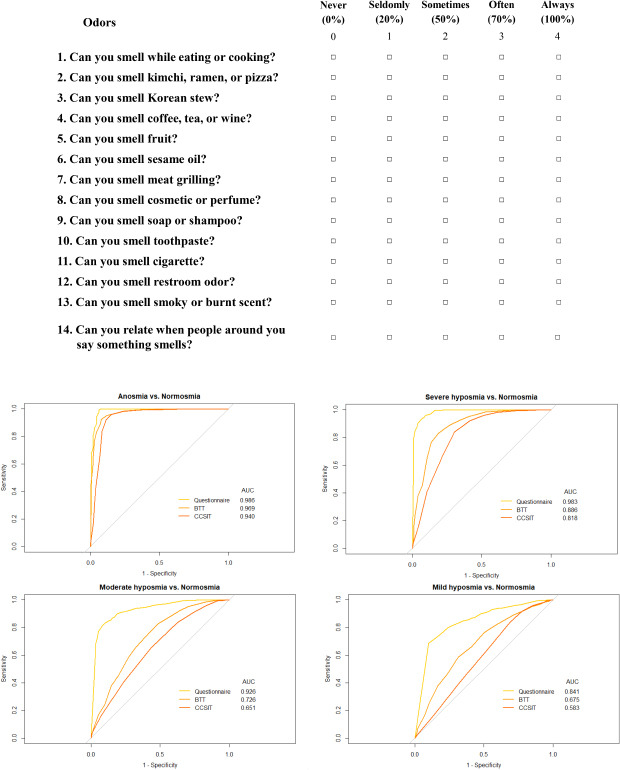1. Hong SM, Park IH, Kim KM, Shin JM, Lee HM. Relationship between the Korean version of the Sniffin' Stick Test and the T&T olfactometer in the Korean population. Clin Exp Otorhinolaryngol. 2011; 4(4):184–187. PMID:
22232713.


2. Kim JM, Jeong MS, Shin DH, Seol JH, Hong SC, Cho JH, et al. Olfactory identification test using familiar distracters for Koreans. Clin Exp Otorhinolaryngol. 2014; 7(1):19–23. PMID:
24587876.



3. Park CW, Do NY, Rha KS, Chung SM, Kwon YJ. Korean Academy of Medical Sciences. Development of guideline for rating the physical impairment of otolaryngologic field. J Korean Med Sci. 2009; 24(Suppl 2):S258–S266. PMID:
19503682.

4. Doty RL, Shaman P, Kimmelman CP, Dann MS. University of Pennsylvania Smell Identification Test: a rapid quantitative olfactory function test for the clinic. Laryngoscope. 1984; 94(2 Pt 1):176–178. PMID:
6694486.


5. Hummel T, Sekinger B, Wolf SR, Pauli E, Kobal G. ‘Sniffin' sticks’: olfactory performance assessed by the combined testing of odor identification, odor discrimination and olfactory threshold. Chem Senses. 1997; 22(1):39–52. PMID:
9056084.

6. Takagi SF. A standardized olfactometer in Japan. A review over ten years. Ann N Y Acad Sci. 1987; 510(1):113–118. PMID:
3481235.
7. Cain WS, Gent J, Catalanotto FA, Goodspeed RB. Clinical evaluation of olfaction. Am J Otolaryngol. 1983; 4(4):252–256. PMID:
6625103.


8. Doty RL, Marcus A, Lee WW. Development of the 12‐item cross‐cultural smell identification test (CC‐SIT). Laryngoscope. 1996; 106(3 Pt 1):353–356. PMID:
8614203.

9. Lechien JR, Chiesa-Estomba CM, De Siati DR, Horoi M, Le Bon SD, Rodriguez A, et al. Olfactory and gustatory dysfunctions as a clinical presentation of mild-to-moderate forms of the coronavirus disease (COVID-19): a multicenter European study. Eur Arch Otorhinolaryngol. 2020; 277(8):2251–2261. PMID:
32253535.

10. Eliezer M, Hautefort C, Hamel AL, Verillaud B, Herman P, Houdart E, et al. Sudden and complete olfactory loss function as a possible symptom of covid-19. JAMA Otolaryngol Head Neck Surg. 2020; 146(7):674–675. PMID:
32267483.

11. Gane SB, Kelly C, Hopkins C. Isolated sudden onset anosmia in COVID-19 infection. A novel syndrome? Rhinology. 2020; 58(3):299–301. PMID:
32240279.


12. Hopkins C, Surda P, Kumar N. Presentation of new onset anosmia during the COVID-19 pandemic. Rhinology. 2020; 58(3):295–298. PMID:
32277751.


13. Lee Y, Min P, Lee S, Kim SW. Prevalence and duration of acute loss of smell or taste in COVID-19 patients. J Korean Med Sci. 2020; 35(18):e174. PMID:
32383370.

14. Takebayashi H, Tsuzuki K, Oka H, Fukazawa K, Daimon T, Sakagami M. Clinical availability of a self-administered odor questionnaire for patients with olfactory disorders. Auris Nasus Larynx. 2011; 38(1):65–72. PMID:
20594785.

15. Frasnelli J, Hummel T. Olfactory dysfunction and daily life. Eur Arch Otorhinolaryngol. 2005; 262(3):231–235. PMID:
15133691.

16. Nordin S, Brämerson A, Murphy C, Bende M. A Scandinavian adaptation of the Multi-Clinic Smell and Taste Questionnaire: evaluation of questions about olfaction. Acta Otolaryngol. 2003; 123(4):536–542. PMID:
12809108.


17. Langstaff L, Pradhan N, Clark A, Boak D, Salam M, Hummel T, et al. Validation of the olfactory disorders questionnaire for English-speaking patients with olfactory disorders. Clin Otolaryngol. 2019; 44(5):715–728. PMID:
31038840.


18. Zou L, Linden L, Cuevas M, Metasch ML, Welge‐Lüssen A, Hähner A, et al. Self‐reported mini olfactory questionnaire (Self‐MOQ): a simple and useful measurement for the screening of olfactory dysfunction. Laryngoscope. 2019.

19. Seok J, Shim YJ, Rhee CS, Kim JW. Correlation between olfactory severity ratings based on olfactory function test scores and self-reported severity rating of olfactory loss. Acta Otolaryngol. 2017; 137(7):750–754. PMID:
28112015.


20. Bujang MA, Baharum N. Guidelines of the minimum sample size requirements for Kappa agreement test. Epidemiol Biostat Public Health. 2017; 14(2):e12267.
21. Cohen J. A coefficient of agreement for nominal scales. Educ Psychol Meas. 1960; 20(1):37–46.

22. Landis JR, Koch GG. The measurement of observer agreement for categorical data. Biometrics. 1977; 33(1):159–174. PMID:
843571.


23. Flack VF, Afifi A, Lachenbruch P, Schouten H. Sample size determinations for the two rater kappa statistic. Psychometrika. 1988; 53(3):321–325.

24. Meng XL, Rosenthal R, Rubin DB. Comparing correlated correlation coefficients. Psychol Bull. 1992; 111(1):172–175.

25. Moein ST, Hashemian SM, Mansourafshar B, Khorram-Tousi A, Tabarsi P, Doty RL. Smell dysfunction: a biomarker for COVID-19. Int Forum Allergy Rhinol. 2020; 10(8):944–950. PMID:
32301284.


26. Choi HG, Lee HJ, Shin HW, Lee JM, Lee CH, Mo JH, et al. Correlation between olfactory threshold test, olfactory identification test and subjective symptoms. Korean J Otorhinolaryngol-Head Neck Surg. 2008; 51(11):1015–1019.
27. Schriever VA, Han P, Weise S, Hösel F, Pellegrino R, Hummel T. Time frequency analysis of olfactory induced EEG-power change. PLoS One. 2017; 12(10):e0185596. PMID:
29016623.

28. Bonanni E, Borghetti D, Fabbrini M, Maestri M, Cignoni F, Sartucci F, et al. Quantitative EEG analysis in post-traumatic anosmia. Brain Res Bull. 2006; 71(1-3):69–75. PMID:
17113930.










 PDF
PDF Citation
Citation Print
Print






 XML Download
XML Download